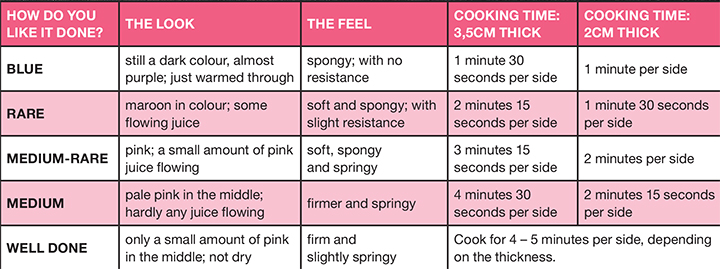How to cook the perfect steak
In avoiding incidents of steak not cooked to your guests’ liking, we’ve put together your right-hand guide on how to cook the perfect steak, from mise en place to serving.
Words and Styling by Claire Ferrandi
Assisted by Nomvuselelo Mncube
Photograph by Dylan Swart
Before you start – Selecting your steak
The first step in cooking the perfect steak is selecting it at your local butcher or grocery store. The cut you choose depends on your preference. These are our favourites for pan-frying…
FILLET: This prized cut of steak is very tender and costly; however, what it makes up for in tenderness, it generally lacks in flavour (compared to other cuts). Best served as rare as you like it.
SIRLOIN: Considered a prime steak, similar to fillet, with more flavour but less tender. Best served medium-rare.
RIB EYE: Flavourful with a thick strip of fat. Best served medium-rare.
RUMP: Flavourful and more affordable. Best served medium-rare.
Preparing your steak
MARINATING: Remove your steak from the fridge 30 minutes before you plan to fry it and place it in a large, flat dish. Rub with just enough Westfalia Garlic or Lemon Flavoured Avocado Oil to lightly coat the steak. Bringing your steak to room temperature will ensure it cooks evenly. Although the jury is out on whether to salt your steak before or after cooking, I prefer to season it generously with sea salt flakes and a good crack of freshly ground black pepper 30 minutes before cooking (any earlier and you risk the salt drawing moisture from your steak). You can either simply marinate as per above or add these flavour twists after marinating with oil and seasoning, by rubbing it with:
- A generous handful finely chopped rosemary leaves
- A generous handful fresh thyme leaves and a splash of balsamic vinegar
- Chopped fresh chilli flakes and a splash of soya sauce
Cooking your steak
THE PAN: I love using a heavy-based cast iron pan to cook steak, but any heavy-based pan will do (a heavy base heats evenly and gets very hot – essential to getting that delicious charring on the outside of your steak).
FRYING: Heat the pan over very high heat, without oil, as you’ve already used avocado oil to marinate your steak – the versatility of avocado oil means that not only is it ideal for marinating ingredients, its high smoke point of 250°C also makes it the perfect choice of oil for drizzling, dipping, frying, roasting and braaiing. What’s more, it is suitable for vegetarians and vegans. When the pan is sizzling hot, add the steak (if your steak has a layer of fat, fry that first, about 1 minute, holding the steak in this position, to crisp up the fat), then lay the steak in the pan and start your timer. Flip your steak only once and 1 minute before the end of cooking, add a big knob of butter to the pan for a creamy flavour. Baste the steak with the pan juices. As tempting as it can be, don’t overcrowd your pan – if cooking several steaks, cook them in batches.
How do you like your steak done?
Post-cooking
RESTING: Leave your steak to rest on a chopping board for 10 minutes – doing this ensures your meat retains its juices and the fibres relax for a tender steak.
SLICING: Using a very sharp, non-serrated knife, slice your steak across the grain for a more tender, easier-to-chew meal. To do this, look for the long striations that run across the steak and slice against them, not with them (you may have to move your steak as you slice, as the grain doesn’t always run in the same direction through the entire steak).
SERVING: Sprinkle with a little more sea salt flakes, if desired (I prefer a very well-seasoned steak). Serve with béarnaise sauce or creamed horseradish.
ALSO SEE: Roasted artichokes burrata
ALSO SEE: Citrus panzanella with parmesan chips



